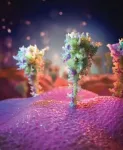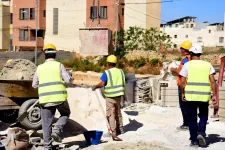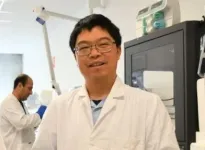First images of cells exposed to COVID-19 vaccine reveal native-like Coronavirus spikes
2021-04-07
(Press-News.org) New research has for the first time compared images of the protein spikes that develop on the surface of cells exposed to the Oxford-AstraZeneca vaccine to the protein spike of the SARS-CoV-19 coronavirus. The images show that the spikes are highly similar to those of the virus and support the modified adenovirus used in the vaccine as a leading platform to combat COVID-19.
The SARS-CoV-2 virus, which causes COVID-19, has a large number of spikes sticking out of its surface that it uses to attach to, and enter, cells in the human body. These spikes are coated in sugars, known as glycans, which disguise parts of the viral proteins to the human immune system.
The vaccine developed by the University of Oxford and AstraZeneca is an adenovirus-vectored vaccine, which involves taking a safe version of a virus and adding in the information from part of a pathogen, in this case the SAR-CoV-2 spike, in order to generate neutralising antibodies against that target.
In this new study, published in the journal ACS Central Science, scientists from the University of Oxford and the University of Southampton, worked together to characterise the SARS-CoV-2 spikes manufactured by the cells presented with the Oxford-AstraZeneca vaccine. The Oxford work was led by Professors Teresa Lambe, Peijun Zhang and Sarah Gilbert and Professor Max Crispin led the work in Southampton.
The Scientists exposed a range of cells in vitro to the Oxford-AstraZeneca vaccine. Using an imaging technique known as cryo-electron microscopy (cryoEM) they took thousands of images which they then combined to build up a clear picture of the resulting protein spikes on the cells. Professor Peijun Zhang, of the University of Oxford and the Electron Bio-Imaging Centre (eBIC) at Diamond Light Source, who led the imaging work said, "CryoEM is an immensely powerful technique which enabled us to visualise the dense array of spikes that had been manufactured and presented on the surface of the cells".
Further chemical analysis of the glycans that coat the newly developed protein spikes revealed that they bear a high resemblance to those surrounding the SARS-CoV-2 spikes. This is an essential feature of the vaccine as it means that it can deliver close mimics of the coronavirus that are important in triggering the immune response needed to protect against COVID-19.
Professor Crispin said, "In this study we set out to see how closely the vaccine induced spikes resembled those of the infectious virus. We were really pleased to see a large amount of native-like spikes."
"This study will hopefully provide further understanding for the public, helping them see how the Oxford-AstraZeneca vaccine works. Many people may not realise how their cells become little factories manufacturing viral spikes that then trigger the immune response needed to fight off the disease. This may also provide reassurance that the vaccine is doing its job and generating the material that we need to present to our immune systems."
INFORMATION:
[Attachments] See images for this press release:

ELSE PRESS RELEASES FROM THIS DATE:
2021-04-07
Researchers at the Francis Crick Institute, as part of an international collaboration of scientists through the Pan-Cancer Analysis of Whole Genomes Consortium, have analysed the whole genomes of tumour samples from over 2,600 patients with different types of cancer. They identified a high prevalence of genetic diversity within individual tumours, which they further characterised. Their findings confirm that, even at late stages of development, tumour evolution is driven by changes that benefit the cancer.
When cancer cells divide, errors occur in the process of copying their DNA. These copying errors mean that different tumours can be made up of cells presenting a wide range of genetic diversity. This variation is a challenge for doctors as a treatment that ...
2021-04-07
Digitalisation can support transitions towards a more sustainable society if technologies and processes are designed in line with suitable criteria. This requires a systemic focus on the risks and benefits of digital technologies across the three dimensions of sustainable development: the environment, society, and the economy. This is the conclusion of a study prepared by a team of researchers at the Institute for Advanced Sustainability Studies (IASS) in Potsdam. Applying this precautionary approach to digitalisation requires the active involvement of developers, users, and regulators.
Digitalisation ...
2021-04-07
ALS is a progressive neurological disease that attacks the nerves that interact with the body's muscles. The disease typically leads to complete paralysis of the body, robbing patients of their ability to walk, speak, eat and breathe.
Researchers studied ALS patients and healthy elderly volunteers living in Malta who took part in an ongoing study aiming at identifying genetic and environmental risk factors. Malta is a sovereign microstate in the middle of the Mediterranean Sea, and is home to a geographically and culturally isolated population. Recently, Maltese ALS patients were found to have a unique genetic makeup compared to ...
2021-04-07
Bishop Peder Winstrup died in 1679, and is one of the most well-preserved human bodies from the 1600s. Researchers at Lund University in Sweden may now have solved the mystery of why a foetus was hidden in his coffin in Lund Cathedral. DNA from the bishop and the foetus, along with kinship analyses, has shown that the child was probably the bishop's own grandson.
Something is protruding between Bishop Peder Winstrup's two calves. The X-ray reveals small bones. Could it be an animal? When the image is studied more closely, the osteologists from Lund University can see faint signs of what is to become ...
2021-04-07
A novel way to pinpoint and illuminate bone damage promises to make X-rays more efficient at diagnosing bone and other injuries, Flinders University researchers say.
The new technique, looking at potential biomedical applications of an ancient inorganic salt-based aggregation induced emission (AIE) radio-luminescence material, could open new frontiers in medicine including X-ray dosimetry, bioimaging and advanced applications such as optogenetics, says Professor Youhong Tang, from Flinders University's College of Science and Engineering.
The review article, published by Professor Tang, postdoctoral student Dr Javad Tavokoli, colleagues in Hong Kong and Australian technology company Micro-X and, examined the potential of the AIEgen luminogens ...
2021-04-07
Sweden's acclaimed research on uterine transplants has taken a new step forward: into the field of health economics. Now, for the first time, there is a scientifically based estimate of how much implementing the treatment costs.
The current research is based on the nine uterine transplants from living donors carried out in 2013, under the leadership of Mats Brännström, Professor of Obstetrics and Gynecology at Sahlgrenska Academy, University of Gothenburg, and Chief Physician at Sahlgrenska University Hospital.
The transplants were performed within the scope of the world's first systematic, scientifically based study in the field. After ...
2021-04-07
If relatives of people with mental illness become better at accepting the difficult emotions and life events they experience - which is what training in compassion is about - their anxiety, depression and stress is reduced. These are the results of a new study from the Danish Center for Mindfulness at Aarhus University.
Being a relative of a person with a mental illness can be very burdensome. It can feel like a great responsibility, and many people struggle with feelings of fear, guilt, shame and anger. A new study from the Danish Center for Mindfulness shows that eight weeks of training in compassion can significantly improve the well-being of relatives.
Compassion is a human quality that is anchored in the recognition of and desire to relieve ...
2021-04-07
Tsukuba, Japan - Dermatomyositis is an idiopathic inflammatory myopathy that has been regarded as an autoimmunity-based disorder, although its pathogenesis remains unclear. In this study, researchers from the University of Tsukuba used a mouse model to identify a mechanism by which dermatomyositis may develop in humans. The animal model and findings can be used to better understand the disease and develop disease-specific treatments.
Dermatomyositis belongs to a group of idiopathic inflammatory myopathies that are associated with the presence of specific autoantibodies in patient sera. Multiple myositis-specific autoantibodies, which target proteins ubiquitously expressed in the nucleus or cytoplasm, have been described. One ...
2021-04-07
A team of scientists led by Nanyang Technological University, Singapore (NTU Singapore) has created a reusable, biodegradable sponge that can readily soak up oil and other organic solvents from contaminated water sources, making it a promising alternative for tackling marine oil spills.
Made of sunflower pollen, the sponge is hydrophobic - it repels water - thanks to a coat of natural fatty acid on the sponge. In lab experiments, the scientists showed the sponge's ability to absorb oil contaminants of various densities, such as gasoline and motor oil, ...
2021-04-07
Astronomers have found two close pairs of quasars in the distant Universe. Follow-up observations with Gemini North spectroscopically resolved one of the distant quasar pairs, after their discovery with the Hubble Space Telescope and Gaia spacecraft. These quasars are closer together than any pair of quasars found so far away, providing strong evidence for the existence of supermassive black hole pairs as well as crucial insight into galaxy mergers in the early Universe.
The quasars in each of the two pairs are separated by just over 10,000 light-years, suggesting ...
LAST 30 PRESS RELEASES:
[Press-News.org] First images of cells exposed to COVID-19 vaccine reveal native-like Coronavirus spikes



